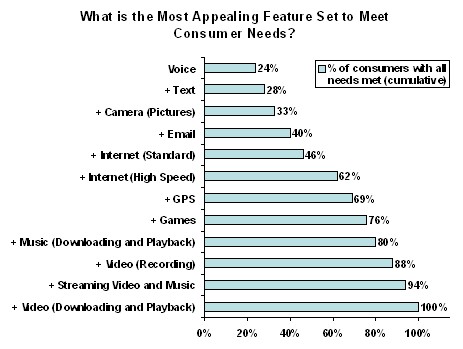Design decisions are typically affected by two conflicting constraints: not enough versus too many. There is a need to identify and include all the necessary features to make a product or service valuable to its consumers. However, there is also a need to avoid an excess of features, since this can drive up costs, increase “feature fatigue,” and slow development. (See related article: “Feature Fatigue: When Product Capabilities Become Too Much of a Good Thing”) The issue affects a wide range of products and services. For instance, a manufacturer may seek a “short list” of core features to make a product viable in the market (see case study on portable device). An e-commerce portal may seek a core set of applications or content features to maximize incentive to visit the site.
Market research can address this question through the use of TURF1 Analysis, a methodology that identifies underlying duplication across features in satisfying customer requirements. To illustrate, Rockbridge surveyed businesses for a communications services provider on which features they would desire in a one-stop web portal. Our client wanted to include features that were compelling enough to encourage customers to continually visit the portal, but did not wish to fund and develop every feature under consideration. If a critical feature was included that appealed to one particular type of visitor, it would be wasteful to include an additional feature that appealed to the same type of visitor unless it also attracted a different customer type, therefore extending the portal’s “reach.” TURF analysis identified a short list of approximately half the features under consideration. The list excluded features that were of little value and avoided features that were redundant with others with broader appeal.
The input for a TURF analysis is a series of ratings of product or service features that might be included in a new product design. The method of rating features depends on the study goals. In the example above, business owners rated web portal features by their likelihood of motivating them to visit the portal. For many products, the chosen scale captures criticality because the goal is to identify a core group that makes the offering viable. Criticality is important with cutting edge technologies and internet-based services where the first in the market must contain a core group of features to ensure acceptance, while delays in development can spoil the “first to market” advantage.
Case Study: If you could carry just one portable device, what would it include? In an increasingly portable environment, Rockbridge sought to identify a short list of features that should be included in a portable device to maximize appeal. The question is timely because of the abundance of technologies, from the iPhone to the Blackberry, and research on “Feature Fatigue” that reveals an excess of features in technology products can lead to buyer dissatisfaction. Rockbridge surveyed consumers about which features they felt they “must have,” “would like to have,” or “did not need” if they could carry only one device. TURF analysis revealed that two-thirds of consumers could have all their needs met with just four features. However, because no four features appealed to all consumers, it would take a device with six to seven features to satisfy the critical needs of two-thirds of potential users.
The same study also identified the core features that a portable device needs for mass appeal. Only a third of the market would have all their needs fulfilled with the standard voice, messaging and camera features. A device with mass appeal would also need email and standard and high speed Internet access, while the addition of GPS would increase reach by another 7 percent. The fundamental point of the study is that providers will have difficulty avoiding feature fatigue, but it also illustrates how TURF can be used to design a product with maximum appeal and minimum features.
To learn more about this case study read: “Feature Fatigue: A Necessary Evil in Portable Devices””


